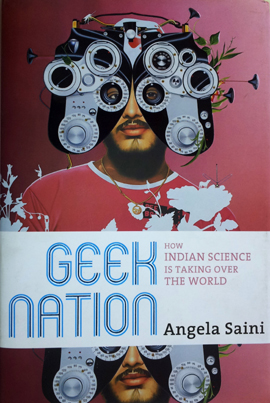Geek Nation: How Indian Science is Taking over the World
By Angela Saini.
Hodder & Stoughton/Hachette.
Pages 288. Rs 499.
A well-informed look at the world of science in India today
INDIAN techies have made a place for themselves the world over, so much so that they have eclipsed the achievers from their mother discipline, science. The IITs and other scientific institutions owe much to Jawaharlal Nehru who insisted that every Indian citizen should develop “scientific temper, humanism and the spirit of inquiry and reform”.

It is common to see snapshots of contrarian symbols of India, rich/poor, advanced/backward, educated/uneducated and so on. It takes a passionate observer to go beyond them, which this writer has done in her journey to the land she believes was the birthplace of the geek.
The story goes back to 700 AD, when the Bakhshali manuscript is believed to have been written. It is one of the earliest scientific texts in Asia, and is now at the Bodleian Library at Oxford University, the author’s alma matter.
The author is a master’s in engineering and science journalist, and the combination makes for not only an engaging read but also a remarkably well-informed look at the world of science in India today. She takes us to the Vikram Sarabai Space Centre, and to a “small Hindu town of Melkote”.
Through her we meet the 88-year-old Prof. Udupi Ramachandra Rao, a space scientist and former chairman of the Indian Space Research Organisation. The redoubtable Naryana Murthy, who needs no introduction, Dr Pravendra Nath, a molecular biologist working on genetically modified bananas, Vandana Shiva, the scientist-turned activist who is leading the anti-GM fight in India, and a host of other committed individuals who give us many insights into scientific research in India.
Many of us know the tale of how someone’s blunder was the cause of Indians getting major exposure in the international stage, but the story bears revisiting. It was in the mid-1990s that Western governments and business woke up to the fact that many of their mainframe computers used programmes in which only the last two digits of the year was mentioned. Thus, as far as the computers were concerned, the year 2000 could well be 1900, 1800, whatever. With the year 2000 approaching, millions of lines of code had to be written, or all kinds of problems could arise in various sectors, including banks, airlines, public utilities, even nuclear installations, which used old mainframe computers, and more importantly, code written for them.
Indians were better qualified than others to do this because of their technical education as well as their knowledge of English. By the time the millennium bug had been tackled, Indian techies were an established force. However, Indian programmers were known to work like drones, and were not known to be innovators. But this is changing. While many IIT students are burned out by the time they get there, and how there is a movement within the IITs to counteract it, by creating Technocracy, a new group designed to give everyone the chance to build practical skills in their own time. Initiatives like this and increased funding have resulted in more focus on research, and a larger number of patents being issued to IITians.
Saini explores how science and religion co-exist in India, so much so that there are many who claim that scientific knowledge has it origins in ancient Indian texts. She meets Sanskrit scholars and sees their blueprint of an ancient aircraft described in the Vaimanika Shastra, translated by G.R. Josyer, in 1946. She also finds the paper by five researchers at the Indian Institute of Science in Bengalaru, who ripped apart the text.
If religion has many believers in India, so does science. Sometimes I wonder how we can accept brain scanner, or a “mind-reading machine”. The writer investigates the claims of C.R. Mukndan, the machine’s inventor, and finds no validation for his invention in the international scientific community. Yet, the “scientific” evidence based on this device is cited, and accepted, in courts.
We know of Lavasa when its environmental transgressions hit headlines. The author talks of it as the first city designed for Generation Y. She also talks of how people who were displaced because of this development throw stones at cars going in and out of the area.
We are informed about the e-governance initiatives that are being undertaken, even in courts, of cutting edge research in medicine and genomes, of mindsets regarding patents, even visit the 97th Indian Science Congress, where Prime Minister Manmohan Singh made his “The empires of the future are going to be the empires of the mind”, statement.
The writer combines pragmatism with passion. Through this journey we learn to appreciate the possibilities of change around us, and it leaves us looking at the future quite positively.
This review by Roopinder Singh was published in the Spectrum section of The Tribune on July 3, 2011.
